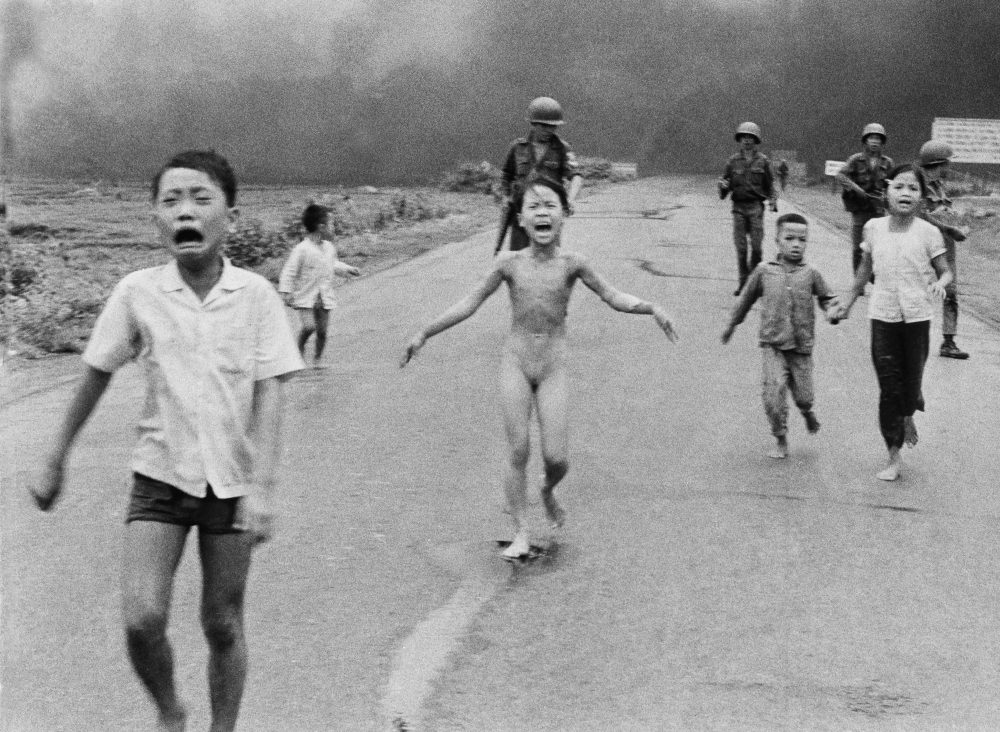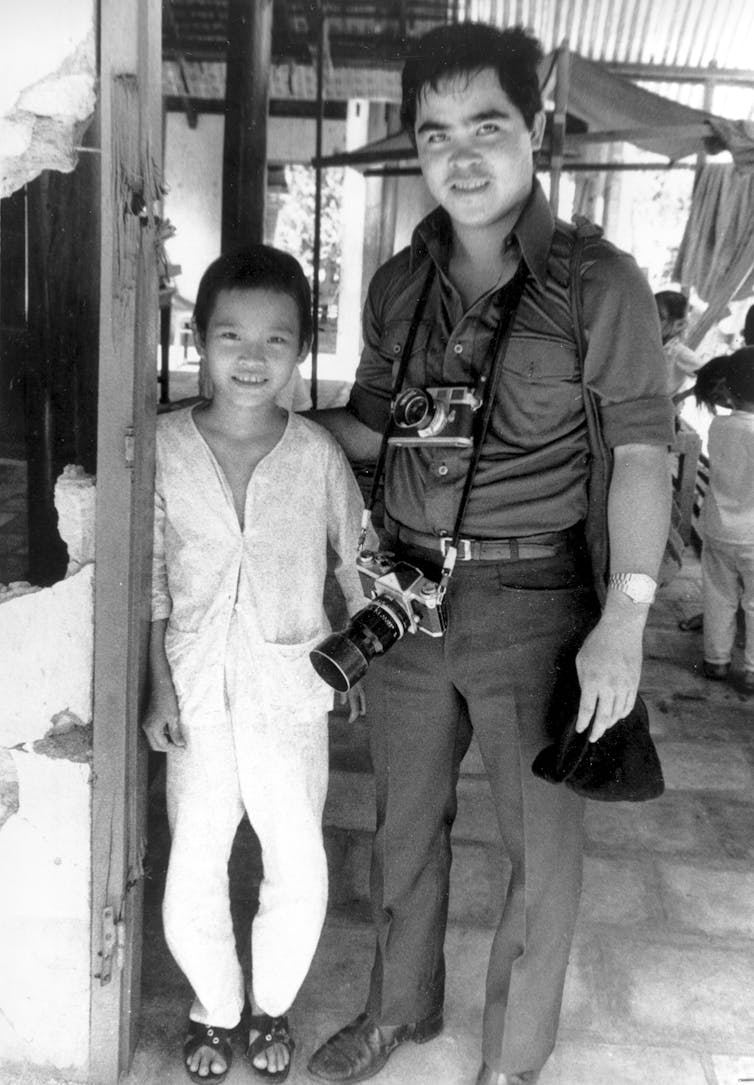
By W. Joseph Campbell
The “Napalm Girl” photograph of terror-stricken Vietnamese children fleeing an errant aerial attack on their village, taken 50 years ago this month, has rightly been called “a picture that doesn’t rest.”
It is one of those exceptional visual artifacts that draws attention and even controversy years after it was made.
In May 2022, for example, Nick Ut, the photographer who captured the image, and the photo’s central figure, Phan Thi Kim Phuc, made news at the Vatican as they presented a poster-size reproduction of the prize-winning image to Pope Francis, who has emphasized the evils of warfare.
In 2016, Facebook stirred controversy by deleting “Napalm Girl” from a commentary posted at the network because the photograph shows the then-9-year-old Kim Phuc entirely naked. She had torn away her burning clothes as she and other terrified children ran from their village, Trang Bang, on June 8, 1972. Facebook retracted the decision amid an international uproar about the social network’s free speech policies.
Such episodes signal how “Napalm Girl” is much more than powerful evidence of war’s indiscriminate effects on civilians. The Pulitzer Prize-winning image, formally known as “The Terror of War,” has also given rise to tenacious media-driven myths.

AP photo
Widely believed – often exaggerated
What are media myths?
These are well-known stories about or by the news media that are widely believed and often retold but which, under scrutiny, dissolve as apocryphal or wildly exaggerated.
The distorting effects of four media myths have become attached to the photograph, which Ut made when he was a 21-year-old photographer for The Associated Press.
Prominent among the myths of the “Napalm Girl,” which I address and dismantle in my book “Getting It Wrong: Debunking the Greatest Myths in American Journalism,” is that U.S.-piloted or guided warplanes dropped the napalm, a gelatinous, incendiary substance, at Trang Bang.
Not so.
The napalm attack was carried out by propeller-driven Skyraider aircraft of the South Vietnamese Air Force trying to roust communist forces dug in near the village – as news accounts at the time made clear.
The headline over The New York Times’ report from Trang Bang said: “South Vietnamese Drop Napalm on Own Troops.” stated the “napalm [was] dropped by a Vietnamese air force Skyraider diving onto the wrong target.” Christopher Wain, a veteran British journalist, wrote : “These were South Vietnamese planes dropping napalm on South Vietnamese peasants and troops.”
The myth of American culpability at Trang Bang began taking hold during the 1972 presidential campaign, when Democratic candidate George McGovern referred to the photograph in a televised speech. The napalm that badly burned Kim Phuc, he declared, had been “dropped in the name of America.”
McGovern’s metaphoric claim anticipated similar assertions, including Susan Sontag’s statement in her 1973 book “On Photography,” that Kim Phuc had been “sprayed by American napalm.”

New York Times archive
Hastened the war’s end?
Two other related media myths rest on assumptions that “Napalm Girl” was so powerful that it must have exerted powerful effects on its audiences. These myths claim that the photograph hastened an end to the war and that it turned U.S. public opinion against the conflict.
Neither is accurate.
Although most U.S. combat forces were out of Vietnam by the time Ut took the photograph, the war went on for nearly three more years. The end came in April 1975, when communist forces overran South Vietnam and seized its capital.
Americans’ views about the war had turned negative long before June 1972, as measured by a survey question the Gallup Organization posed periodically. The question – essentially a proxy for Americans’ views about Vietnam – was whether sending U.S. troops there had been a mistake. When the question was first asked in summer 1965, only 24% of respondents said yes, sending in troops had been a mistake.
But by mid-May 1971 – more than a year before “Napalm Girl” was made – 61% of respondents said yes, sending troops had been mistaken policy.
In short, public opinion turned against the war long before “Napalm Girl” entered popular consciousness.
Ubiquitous? Not exactly
Another myth is that “Napalm Girl” appeared on newspaper front pages everywhere in America.
Many large U.S. daily newspapers did publish the photograph. But many newspapers abstained, perhaps because it depicted frontal nudity.
In a review I conducted with a research assistant of 40 leading daily U.S. newspapers – all of which were Associated Press subscribers – 21 titles placed “Napalm Girl” on the front page.
But 14 newspapers – more than one-third of the sample – did not publish “Napalm Girl” at all in the days immediately after its distribution. These included papers in Dallas, Denver, Detroit, Houston and Newark.
Only three of the 40 newspapers examined – The Boston Globe, the New York Post and The New York Times – published editorials specifically addressing the photograph. The editorial in the New York Post, then a liberal-minded newspaper, was prophetic in saying:
“The picture of the children will never leave anyone who saw it.”
![]()
W. Joseph Campbell is Professor of Communication Studies at American University School of Communication.





























Steve Robinson says
This is a strange essay. Calling the assertions Campbell cites in the piece “myths” is a curious way to revisit an extraordinary image. For starters, as he himself points out, it was well reported at the time that the napalm was dropped by South Vietnamese forces, and neither of the quotes he cites, from McGovern and Sontag, disputes this. McGovern’s obvious point was that, by the time the photo was taken, the only thing even keeping ARVN in the fight was US resistance to completely withdraw from Vietnam. Sontag’s quote that the children in the picture were “sprayed by American napalm” is entirely factual. I would be happy to have someone fact-check this, but I am quite certain that napalm was made exclusively by Dow Chemical, then and now a US-based company. Dow was awarded a contract to manufacture jellied gasoline to be used as an offensive weapon in the 1960s, and if any other company was awarded a similar contract, I will stand corrected.
Was the photo instrumental in turning American opinion against the war? The link Campbell provides is an eight-year-old article by an art critic, who mentions the photograph in passing. In terms of fact-checking this assertion, beyond asking who else other than said art critic has uttered it, in terms of influencing public opinion it is difficult to isolate Ut’s photo from numerous other still and televised images that documented the suffering of the Vietnamese people and the futility of the US war effort, . But collectively, there is no question that media coverage of the war in that pre-24-hour-news-and-internet era shaped public opinion. Recall that LBJ himself asserted that the war effort was doomed when Walter Cronkite announced his opposition (those were the days!).
As for how widely the photograph was disseminated, to nitpick numbers 50 years after the fact is, to be blunt, silly. The photo is one of the most enduring since the invention of the camera.
“Apocryphal”? “Wildly exaggerated”? I don’t think so.
Pogo says
@Steve Robinson
I agree completely.
Thank you.
ULTRA MAGA says
War is TERRIBLE! Friendly Fire happens! I could NOT understand WHY the Vietnam War(which the French FAILED to keep as their colony) happen when Communist Cuba(which had USSR Military Bases) was just 90 miles across from American!
Today, Russia has Invaded Ukraine and China is Preparing to Taiwan while Iran continues to Build Nuclear Weapons! Forget Anti-Climate Change Programs in America when India and China continue to Build Coal-Fired Power Plants!
Appeasement is always a delay for future Wars! The League of Nations could stopped Hitler when he Invaded the Rhineland!
Jim R says
Well written, Mr Robinson. My thoughts mirrored yours as I read the essay. American product dropped in the name of America. No heresy there!
Skibum says
I believe that journalism as a whole in America has been tainted by our country’s political divide just as much as American citizens have, which is very unfortunate. I long for the days of Walter Cronkite and other reputable journalists as well as media networks that strived diligently to report factual news without any political bent or agenda. I’m smart enough to realize that some media networks believe they have had no choice but to lean a certain way to counter the obvious political bent as well as downright falsifications presented in some unscrupulous, but popular media networks, but it has just caused more and more political divide and agenda driven news in America. I’m not sure if the polarization in Congress is the result of the political divide in the news media and journalism, or if the opposite is true. I do believe they are connected, and it would be a great thing for our nation if we could return to the “just the facts, mam” type of true journalism and news on ALL of the TV networks, and let the people decide which facts are relevant to their lives.
Sherry says
@ Skibum. . . always enjoy your well reasoned comments. Try the APNEWS site for more facts. The BBC News on TV has pretty balanced reporting, and of course PBS.
Gina Weiss says
That picture remains in my mind as clear as day and did shape American opinion as we as teens and young adults marched in protest in NYC streets, correct me if I’m wrong but I do remember the news channels posting the names of our fallen soldiers so scary and so sad, I believe following that was the Kent State massacres, so much to learn during those trying times and at times I do wonder about today did we ever learn anything at all?
John Fotheringham says
Reading this, an apologia for the crimes of US imperialism, gave me the same sensation as stepping in something putrid. I sincerely hope that the author never has to face the kind of human misery his country inflicted on innocent people in South East Asia. Only in an American publication could you hope to find anything as nauseating as this.